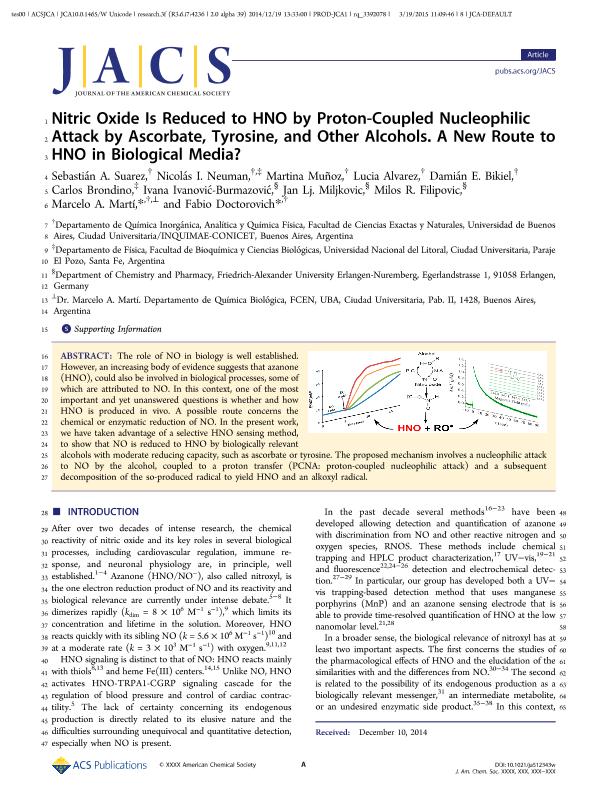Artículo
Nitric oxide is reduced to HNO (azanone) by ascorbic acid, tyrosine, and other alcohols. A new route for azanone formation in biological media.
Suarez, Sebastian ; Neuman, Nicolás Ignacio
; Neuman, Nicolás Ignacio ; Marti, Marcelo Adrian
; Marti, Marcelo Adrian ; Álvarez, Lucía
; Álvarez, Lucía ; Bikiel, Damian Ezequiel
; Bikiel, Damian Ezequiel ; Brondino, Carlos Dante
; Brondino, Carlos Dante ; Ivanovic Burmazovic, Ivana; Miljkovic, Jan Lj.; Filipovic, Milos R.; Marti, Marcelo Adrian
; Ivanovic Burmazovic, Ivana; Miljkovic, Jan Lj.; Filipovic, Milos R.; Marti, Marcelo Adrian ; Doctorovich, Fabio
; Doctorovich, Fabio
 ; Neuman, Nicolás Ignacio
; Neuman, Nicolás Ignacio ; Marti, Marcelo Adrian
; Marti, Marcelo Adrian ; Álvarez, Lucía
; Álvarez, Lucía ; Bikiel, Damian Ezequiel
; Bikiel, Damian Ezequiel ; Brondino, Carlos Dante
; Brondino, Carlos Dante ; Ivanovic Burmazovic, Ivana; Miljkovic, Jan Lj.; Filipovic, Milos R.; Marti, Marcelo Adrian
; Ivanovic Burmazovic, Ivana; Miljkovic, Jan Lj.; Filipovic, Milos R.; Marti, Marcelo Adrian ; Doctorovich, Fabio
; Doctorovich, Fabio
Fecha de publicación:
03/2015
Editorial:
American Chemical Society
Revista:
Journal of the American Chemical Society
ISSN:
0002-7863
Idioma:
Inglés
Tipo de recurso:
Artículo publicado
Clasificación temática:
Resumen
The role of NO in biology is well established. However, an increasing body of evidence suggests that azanone (HNO), could also be involved in biological processes, some of which are attributed to NO. In this context, one of the most important and yet unanswered questions is whether and how HNO is produced in vivo. A possible route concerns the chemical or enzymatic reduction of NO. In the present work, we have taken advantage of a selective HNO sensing method, to show that NO is reduced to HNO by biologically relevant alcohols with moderate reducing capacity, such as ascorbate or tyrosine. The proposed mechanism involves a nucleophilic attack to NO by the alcohol, coupled to a proton transfer (PCNA: proton-coupled nucleophilic attack) and a subsequent decomposition of the so-produced radical to yield HNO and an alkoxyl radical. (Graph Presented).
Palabras clave:
HNO
,
nitric oxide
,
nucleophilic attack
,
biological media
Archivos asociados
Licencia
Identificadores
Colecciones
Articulos(CCT - SANTA FE)
Articulos de CTRO.CIENTIFICO TECNOL.CONICET - SANTA FE
Articulos de CTRO.CIENTIFICO TECNOL.CONICET - SANTA FE
Articulos(INQUIMAE)
Articulos de INST.D/QUIM FIS D/L MATERIALES MEDIOAMB Y ENERGIA
Articulos de INST.D/QUIM FIS D/L MATERIALES MEDIOAMB Y ENERGIA
Articulos(IQUIBICEN)
Articulos de INSTITUTO DE QUIMICA BIOLOGICA DE LA FACULTAD DE CS. EXACTAS Y NATURALES
Articulos de INSTITUTO DE QUIMICA BIOLOGICA DE LA FACULTAD DE CS. EXACTAS Y NATURALES
Articulos(SEDE CENTRAL)
Articulos de SEDE CENTRAL
Articulos de SEDE CENTRAL
Citación
Suarez, Sebastian; Neuman, Nicolás Ignacio; Marti, Marcelo Adrian; Álvarez, Lucía; Bikiel, Damian Ezequiel; et al.; Nitric oxide is reduced to HNO (azanone) by ascorbic acid, tyrosine, and other alcohols. A new route for azanone formation in biological media.; American Chemical Society; Journal of the American Chemical Society; 137; 14; 3-2015; 4720-4727
Compartir
Altmétricas



